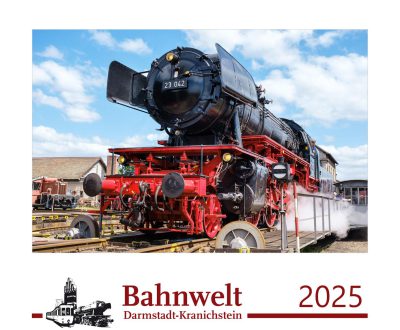Leading axle of the 23 042 removed
After the 23 042 was presented to the expert under steam in mid-December, the planned acceptance run was to take place shortly thereafter in order to check the locomotive in operation and, if necessary, to detect defects that only become apparent during the run. Unfortunately, for organizational reasons, the acceptance run could not take place after all and is to be made up for as soon as possible. During an inspection carried out in the meantime, it became apparent that there was a defect in the Krauss-Helmholtz leading frame, which jeopardized the acceptance of the locomotive. We therefore decided to remove the undercarriage in order to be able to remedy the defect in the short term.
For this purpose, the museum’s axle sink was used, which allows all the axles of a locomotive to be removed without having to lift the entire machine. On the axle sink, the axle to be lowered (including the leading frame) is first supported by a hydraulic ram. Then a piece of the rails about two meters long is pushed aside. The axle is detached from the locomotive chassis and lowered into the pit with the aid of the hydraulic ram. The axle can then be moved to the neighboring track via an underground cross-connection, where it can be brought back to the surface. Alternatively – and as happened in this case – the track is restored above the axle pit, the locomotive is pushed out of the shed, the track is removed again and the axle is lifted.
Relocation of the heavy duty vehicles
At the moment, we are busy sounding out our vehicle collection, partly due to the construction of the stabling and cleaning facility (ARA) for ICE trains on the site of the former Kranichstein marshalling yard by DB Fernverkehr (https://www.boxenstopp-darmstadt.de/).
In the process, the collection of heavy-duty vehicles will also have to move. Unfortunately, the ravages of time have caused some of the road rollers to lose their ability to roll and steer. Therefore, we first salvaged them and then tried wheel by wheel to make them passable again. With up to 8 axles, each with four wheels of a road scooter, this was not an easy undertaking, which occasionally required the use of heavy equipment and a torque wrench with the appropriate extension.
After restoration of the rolling capability, the exhibits are to be moved to the core area and refurbished. After that, a pure collection is to be turned into an exhibition, whereby the amount of road heavy-duty vehicles in different designs at one location is quite unique.
In the course of the construction of the stabling and cleaning facility (ARA) for ICE trains on the site of the former Kranichstein marshalling yard by DB Fernverkehr (https://www.boxenstopp-darmstadt.de/), it is planned that infrastructure for the ARA as well as a new museum island with exhibitions on the history and technology of the marshalling yard will be built in the coming years in the area of the old switchman’s signal box “R1” and the social buildings of the marshalling staff. In order to make the construction measures possible, the site must first be cleared for our part.
Currently, some of the museum’s road rollers and other heavy-duty vehicles are parked there. Unfortunately, the ravages of time have caused some of the vehicles to lose their ability to roll and steer. Therefore, we first salvaged them and then tried wheel by wheel to make them passable again. With up to 8 axles, each with four wheels of a road scooter, this was not an easy undertaking, which occasionally required the use of heavy equipment and a torque wrench with the appropriate extension.
Once rolling stock has been restored, the exhibits will be moved to the core site, refurbished and displayed as part of the heavy-duty vehicle exhibition.



